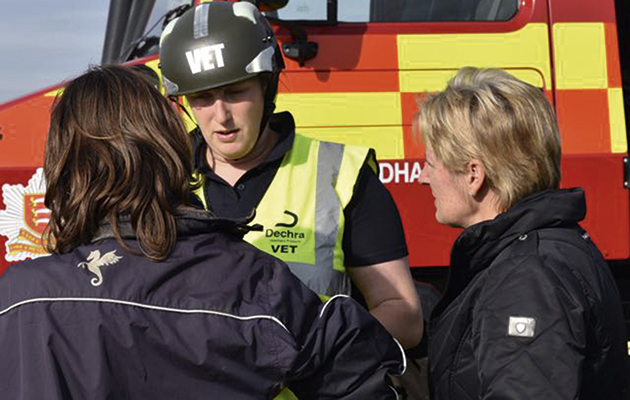Following a spike in the number of claims for fires during 2019, H&H spoke to experts from both insurance companies and the British Horse Society to find out what steps yard owners should be taking...
A warning has been issued to equestrians to ensure they are doing all they can to protect yards and businesses from fire after an increase in incidents.
NFU Mutual reported a year-on-year spike in the number of fire claims in 2018, while KBIS has also had an increase. Although other insurers contacted by H&H have not, all have urged the equestrian community to take precautions.
{"content":"PHA+RmlndXJlcyBmcm9tIE5GVSBNdXR1YWwgcHV0IHRoZSBjb3N0IG9mIGZhcm0gZmlyZXMgaW4gdGhlIFVLLCB3aGljaCBpbmNsdWRlIHN0YWJsZSB5YXJkcywgYXQgYSBmb3VyLXllYXIgaGlnaCBpbiAyMDE4LiBJdHMgc3RhdGlzdGljcyBzaG93IHRoZSB0b3RhbCBjb3N0IGFzIMKjNDYuNG0sIGEgMjcuNSUgcmlzZSBmcm9tIDIwMTcgYW5kIHRoZSBoaWdoZXN0IHRvdGFsIGluIGZvdXIgeWVhcnMuPC9wPgo8cD5FbGVjdHJpY2FsIGZhdWx0cyByZW1haW5lZCB0aGUgbW9zdCBjb21tb24gY2F1c2UsIHJlc3BvbnNpYmxlIGZvciAzNyUgb2YgZmlyZXMsIHdpdGggc3ByZWFkIGZyb20gZWxzZXdoZXJlIOKAlCBzdWNoIGFzIGEgYmFybiBvciBob21lc3RlYWQg4oCUIHNlY29uZCBhdCAyMyUsIGZvbGxvd2VkIGJ5IGFyc29uIGluIHRoaXJkICgyMCUpLjwvcD4KPHA+PGRpdiBjbGFzcz0iYWQtY29udGFpbmVyIGFkLWNvbnRhaW5lci0tbW9iaWxlIj48ZGl2IGlkPSJwb3N0LWlubGluZS0yIiBjbGFzcz0iaXBjLWFkdmVydCI+PC9kaXY+PC9kaXY+PHNlY3Rpb24gaWQ9ImVtYmVkX2NvZGUtMzEiIGNsYXNzPSJoaWRkZW4tbWQgaGlkZGVuLWxnIHMtY29udGFpbmVyIHN0aWNreS1hbmNob3IgaGlkZS13aWRnZXQtdGl0bGUgd2lkZ2V0X2VtYmVkX2NvZGUgcHJlbWl1bV9pbmxpbmVfMiI+PHNlY3Rpb24gY2xhc3M9InMtY29udGFpbmVyIGxpc3RpbmctLXNpbmdsZSBsaXN0aW5nLS1zaW5nbGUtc2hhcmV0aHJvdWdoIGltYWdlLWFzcGVjdC1sYW5kc2NhcGUgZGVmYXVsdCBzaGFyZXRocm91Z2gtYWQgc2hhcmV0aHJvdWdoLWFkLWhpZGRlbiI+DQogIDxkaXYgY2xhc3M9InMtY29udGFpbmVyX19pbm5lciI+DQogICAgPHVsPg0KICAgICAgPGxpIGlkPSJuYXRpdmUtY29udGVudC1tb2JpbGUiIGNsYXNzPSJsaXN0aW5nLWl0ZW0iPg0KICAgICAgPC9saT4NCiAgICA8L3VsPg0KICA8L2Rpdj4NCjwvc2VjdGlvbj48L3NlY3Rpb24+PC9wPgo8cD5UaGUgbG9uZyBzdW1tZXIgYW5kIHRpbmRlci1kcnkgY29uZGl0aW9ucyB3ZXJlIHNpZ25pZmljYW50IGNvbnRyaWJ1dGluZyBmYWN0b3JzLjwvcD4KPHA+4oCcT3VyIGxhdGVzdCBmaWd1cmVzIHNlcnZlIGFzIGEgY3J1Y2lhbCByZW1pbmRlciB0byBiZSBhbGVydCB0byB0aGUgZGFuZ2VyLCBhbmQgaGF2ZSBwbGFucyBwcmVwYXJlZCBhbmQgc2hhcmVkIHdpdGggZmFtaWx5IG1lbWJlcnMgYW5kIHN0YWZmLOKAnSBzYWlkIE5GVSBNdXR1YWwgcnVyYWwgaW5zdXJhbmNlIHNwZWNpYWxpc3QgUmViZWNjYSBEYXZpZHNvbi48L3A+CjxwPuKAnEl0IGlzIHBvc3NpYmxlIHRvIG1hbmFnZSB0aGUgcmlza3MgYnkgdGFraW5nIGFsbCBwb3NzaWJsZSBzdGVwcyB0byBwcmV2ZW50IGZpcmVzIGJyZWFraW5nIG91dCwgYW5kIHRvIGhhdmUgY2xlYXIgcGxhbnMgaW4gcGxhY2UgdG8gZXZhY3VhdGUgcGVvcGxlIGFuZCBsaXZlc3RvY2sgc2FmZWx5IGluIHRoZSBldmVudCBvZiBhIGZpcmUu4oCdPC9wPgo8ZGl2IGNsYXNzPSJhZC1jb250YWluZXIgYWQtY29udGFpbmVyLS1tb2JpbGUiPjxkaXYgaWQ9InBvc3QtaW5saW5lLTMiIGNsYXNzPSJpcGMtYWR2ZXJ0Ij48L2Rpdj48L2Rpdj4KPHA+S0JJUyBleGVjdXRpdmUgZGlyZWN0b3IgTGF3cmVuY2UgR2lsbCB0b2xkIDxlbT5IJmFtcDtIPC9lbT4gZmlyZSBpcyB0aGXCoOKAnGJpZ2dlc3QgY29udHJpYnV0b3IgZmFjdG9y4oCdwqB0byB0aGUgdG90YWwgY2xhaW1zIGFtb3VudCBwYWlkIGJ5IHRoZSBjb21wYW554oCZcyB1bmRlcndyaXRlcnMgZWFjaCB5ZWFyLjwvcD4KPHA+4oCcVGhpcyBpcyBsYXJnZWx5IGJlY2F1c2UgdGhlIGF2ZXJhZ2UgY29zdCBwZXIgY2xhaW0gaW4gcmVzcGVjdCBvZiBmaXJlIGRhbWFnZSBjb21wYXJlZCB0byBvdGhlciBwZXJpbHMgaXMgc2lnbmlmaWNhbnRseSBoaWdoZXIs4oCdwqBzYWlkIE1yIEdpbGwuPC9wPgo8ZGl2IGNsYXNzPSJhZC1jb250YWluZXIgYWQtY29udGFpbmVyLS1tb2JpbGUiPjxkaXYgaWQ9InBvc3QtaW5saW5lLTQiIGNsYXNzPSJpcGMtYWR2ZXJ0Ij48L2Rpdj48L2Rpdj4KPHA+4oCcVGhlIG1ham9yaXR5IG9mIHRoZXNlIGZpcmUgY2xhaW1zIGFyZSBhIHJlc3VsdCBvZiBlbGVjdHJpY2FsIGZhdWx0cyBvciBhcnNvbiwgc28gdGhlIG1vc3QgaW1wb3J0YW50IHRoaW5nIGlzIHRvIHJlZHVjZSB0aGUgYW1vdW50IG9mIGRhbWFnZSB0aGF0IGNhbiBiZSBjYXVzZWQgYnkgYW55IGZpcmUgdGhhdCBkb2VzIHN0YXJ0LjwvcD4KPHA+4oCcU2ltcGxlIG1lYXN1cmVzIGJ1c2luZXNzZXMgY2FuIHRha2UgaW5jbHVkZSBlbnN1cmluZyBlbGVjdHJpY2FsIGl0ZW1zIGFyZSB1bnBsdWdnZWQgd2hlbiBub3QgaW4gdXNlLCBub3QgbGVmdCB1bmF0dGVuZGVkIGFuZCBlbnN1cmluZyBoYXksIHN0cmF3IGFuZCBvdGhlciBlYXNpbHkgZmxhbW1hYmxlIGl0ZW1zIGFyZSBzdG9yZWQgYXdheSBmcm9tIHRoZSBtYWluIGJ1aWxkaW5ncy48L3A+CjxkaXYgY2xhc3M9ImFkLWNvbnRhaW5lciBhZC1jb250YWluZXItLW1vYmlsZSI+PGRpdiBpZD0icG9zdC1pbmxpbmUtNSIgY2xhc3M9ImlwYy1hZHZlcnQiPjwvZGl2PjwvZGl2Pgo8cD7igJxUaGlzIHdpbGwgYXQgbGVhc3QgaGVscCB0byByZWR1Y2UgdGhlIGRhbWFnZSBjYXVzZWQgYnkgZmlyZSwgbWVhbmluZyB0aGF0IGFueSBidXNpbmVzcyBpbnRlcnJ1cHRpb24gc3VmZmVyZWQgYXMgYSByZXN1bHQgb2YgdGhlIGRhbWFnZSBpcyBrZXB0IHRvIGEgbWluaW11bS7igJ08L3A+CjxwPkhlIGFsc28gcmVjb21tZW5kZWQgZWxlY3RyaWNhbCBjaXJjdWl0cyBiZSBpbnNwZWN0ZWQgYnkgYSBxdWFsaWZpZWQgZWxlY3RyaWNpYW4gYXQgbGVhc3QgZXZlcnkgZml2ZSB5ZWFycyBhbmQgZWxlY3RyaWNhbCBpdGVtcyB0byBiZSB0ZXN0ZWQgYW5udWFsbHkuPC9wPgo8cD7igJxFYWNoIGJ1c2luZXNzIHNob3VsZCBoYXZlIGEgZmlyZSB3YXJkZW4gd2hvIGNhbiB3b3JrIGNsb3NlbHkgd2l0aCB0aGUgbG9jYWwgZmlyZSBzZXJ2aWNlLCB3aG8gYXJlIG9mdGVuIGhhcHB5IHRvIGNvbWUgb3V0IGFuZCBwcm92aWRlIGFkdmljZSB0byBidXNpbmVzc2VzIHdpdGggcmVnYXJkIHRvIGZpcmUgcHJldGVudGlvbizigJ3CoGFkZGVkIE1yIEdpbGwuwqDigJxBIGJhbiBvbiBvcGVuIGZpcmVzIGFuZCBzbW9raW5nIG9uIHRoZSBwcm9wZXJ0eSBhcmUgYWxzbyBzaW1wbGUgd2F5cyB0byByZWR1Y2UgdGhlIGxpa2VsaWhvb2Qgb2YgYSBmaXJlIHN0YXJ0aW5nLuKAnTwvcD4KPHA+QSBzcG9rZXNtYW4gZm9yIFNFSUIgc2FpZCB0aGUgY29tcGFueSBoYWQgbm90IHNlZW4gYSBjbGVhciBpbmNyZWFzZSBvZiB5YXJkIGZpcmVzLCBidXQgb2ZmZXJlZCBzb21lIHRpcHMgb24ga2VlcGluZyBzYWZlLjwvcD4KPHA+VGhlc2UgaW5jbHVkZWQgaGF2aW5nIGHCoG5vLXNtb2tpbmfCoHBvbGljeSBvbiB5YXJkcywgc3RvcmluZyBjb21idXN0aWJsZSBtYXRlcmlhbHMgYSBzdWl0YWJsZSBkaXN0YW5jZSBmcm9tIGJ1aWxkaW5ncywgaGF2aW5nIGEgZ29vZCByaXNrIG1hbmFnZW1lbnQgc3RyYXRlZ3kgYW5kIGVuc3VyaW5nIHRoYXQgd29ya2luZyBmaXJlIGV4dGluZ3Vpc2hlcnMgYW5kIGFsYXJtcyBhcmUgb24gc2l0ZS48L3A+CjxwPlNoZWFyd2F0ZXIgdXJnZWQgb3duZXJzIHRvIHRoaW5rIGFib3V0IGluc3VyYW5jZS48L3A+CjxwPuKAnFJpZGVycyBhbmQgb3duZXJzIHdvdWxkIGF1dG9tYXRpY2FsbHkgaW5zdXJlIHRoZWlyIG93biBob21lcyBhZ2FpbnN0IGZpcmUgc28gaW5zdXJpbmcgdGhlaXIgaG9yc2Vz4oCZwqBob21lcyBhZ2FpbnN0IGZpcmUgc2hvdWxkIGJlIHRoZSBuZXh0IGxvZ2ljYWwgc3RlcCzigJ3CoGEgc3Bva2VzbWFuIHRvbGQgPGVtPkgmYW1wO0g8L2VtPi7CoOKAnFdpdGggc28gbWFueSBzdGFibGVzIG9mIGEgd29vZGVuIOKAlCBhbmQgdGhlcmVmb3JlIG1vcmUgZmxhbW1hYmxlIOKAlCBjb25zdHJ1Y3Rpb24sIHRoZXJlIGFyZSBudW1lcm91cyBoYXphcmRzIHRoYXQgY2FuIGJlZmFsbCBhIHN0YWJsZS48L3A+CjxwPuKAnENhbiB5b3UgaW1hZ2luZSB0aGUgZmluYW5jaWFsIGltcGxpY2F0aW9ucyBvZiByZXBsYWNpbmcgYSBzdGFibGUgYnVpbGRpbmcsIGFuZCB0aGUgY29udGVudHMsIG5vdCB0byBtZW50aW9uIHRoZSBlbW90aW9uYWwgaW1wYWN0P+KAnTwvcD4KPHA+T29uYWdoIE1leWVyLCBoZWFkIG9mIGFwcHJvdmVkIGNlbnRyZXMgYXQgdGhlIEJIUywgdG9sZCA8ZW0+SCZhbXA7SDwvZW0+IGl0IGlzIGVzc2VudGlhbCBwcm9wcmlldG9ycyBvZiBhbnkgeWFyZCBkbyBhbGwgdGhleSBjYW4gdG8gcHJldmVudCB0aGUgcmlzayBvZiBmaXJlIGFuZCB0aGF0IHRoZWlyIHN0YWZmIGFyZcKg4oCcZnVsbHkgaW5mb3JtZWTigJ3CoGFib3V0IHRoZXNlLjwvcD4KPHA+4oCcU2l0dWF0aW9ucyB3aWxsIGRpZmZlciBpbiBldmVyeSB5YXJkIGFuZCBzb21lwqBtYXkgYmUgYXQgZ3JlYXRlciByaXNrIHRoYW4gb3RoZXJzLCBzaW1wbHkgZHVlIHRvIHRoZWlyIGxvY2F0aW9uIG9yIGFjY2Vzc2liaWxpdHks4oCdwqBzaGUgc2FpZC48L3A+CjxwPuKAnEl0IGlzIGltcG9ydGFudCB0byBlbnN1cmUgdGhhdCBhbGwgc3RhZmYgYXMgd2VsbCBhcyBjbGllbnRzIGFyZSBmdWxseSBpbmZvcm1lZCB1cG9uIGZpcmUgcHJvY2VkdXJlcywgaW4gcGFydGljdWxhciBtYWtpbmcgc3VyZSB0aGF0IG93bmVycyBvZiBsaXZlcnkgaG9yc2VzIGFjY2VwdCBhbmQgdW5kZXJzdGFuZCB0aGUgcHJvY2VkdXJlcyB0aGF0IHdpbGwgYmUgdGFrZW4gaW4gdGhlIGV2ZW50IG9mIGEgZmlyZSBpbiB0ZXJtcyBvZiBsaWFiaWxpdHkgZm9yIHRoZWlyIGhvcnNlcy7igJ08L3A+CjxwPlNoZSBhZGRlZCBpdCBpcyBhIGxlZ2FsIHJlcXVpcmVtZW50IGZvciBhbGwgYnVzaW5lc3NlcyB0byBoYXZlIGEgcHJldmVudGF0aXZlIGZpcmUgcmlzayBhc3Nlc3NtZW50LiBSaWRpbmcgc2Nob29scyBtdXN0IGFsc28gaGF2ZSBib3RoIHByZXZlbnRhdGl2ZSBtZWFzdXJlcyBhbmQgZW1lcmdlbmN5IHBsYW5zIGluIHBsYWNlIHVuZGVyIGxpY2Vuc2luZyByZWd1bGF0aW9ucy48L3A+CjxwPuKAnEVtZXJnZW5jeSBwbGFucyBtdXN0IGluY2x1ZGUgcHJpb3JpdHkgY29tbXVuaWNhdGlvbnPCoGFuZMKgbWVhc3VyZXMgdG8gc2FmZWx5IGV4dHJpY2F0ZSBwZW9wbGUgYW5kIGhvcnNlcyzigJ3CoHNhaWQgTXMgTWV5ZXIuPC9wPgo8ZGl2IGNsYXNzPSJpbmplY3Rpb24iPjwvZGl2Pgo8cD7igJxQcmFjdGlzaW5nIGEgZmlyZSBkcmlsbCBhbmQgZXZhY3VhdGlvbiBwcm9jZWR1cmUgb24gYSByZWd1bGFyIGJhc2lzIHdvdWxkIGluZm9ybSBiZXN0IHByYWN0aWNlIHdpdGggaXQgYmVpbmcgbWFkZSBjbGVhciB0byBib3RoIHN0YWZmIG1lbWJlcnMgYW5kIGNsaWVudHMgd2hhdCB0aGVpciByb2xlcyB3b3VsZCBiZS7igJ08L3A+CjxwPkJIUyByZWNvbW1lbmRlZCBtZWFzdXJlcyBpbmNsdWRlIGNsZWFywqDigJxubyBzbW9raW5n4oCdwqBzaWduYWdlLCByZWd1bGFyIGRlLWNvYndlYmJpbmcsIHN0b3JpbmcgZmxhbW1hYmxlcyBhcHByb3ByaWF0ZWx5LCByZWd1bGFyIHNhZmV0eSBjaGVja3MgYW5kIGNvbnNpZGVyaW5nIHRoZSBsb2NhdGlvbiBvZiB0aGUgbXVjayBoZWFwLCBoYXkgYW5kIHN0cmF3IGluIHJlbGF0aW9uIHRvIGJ1aWxkaW5ncy48L3A+CjxwPuKAnEFkZGl0aW9uYWxseSwgdGhlIEJIUyB3b3VsZCBhZHZpc2UgY2VudHJlcyB0byBjb250YWN0IHRoZWlyIGxvY2FsIGZpcmUgYnJpZ2FkZSBmb3IgbG9jYXRpb24tc3BlY2lmaWMgYWR2aWNlLOKAncKgc2hlIHNhaWQuPC9wPgo8cD4K"}
You may also be interested in…
Coping with a catastrophe calls for a cool head and an understanding of how horses and humans react under stress,
Library image
Credit: Stock Exchange
The sprinkler system is currently being tested and is set to be launched in the spring
Credit: Carol Bryce
‘I can’t believe someone could do this. I bought the yard in 2015 for my older horses to retire at’
Credit: Cambridgeshire Fire & Rescue Service
Two barns and the majority of the farm's equipment were also destroyed
Credit: Pôle Hippique de Saint-Lô
‘We will never get back what we lost. Our whole life has been broken to pieces. At the same time
Stay in touch with all the news in the run-up to and throughout the major shows and events during 2025 and beyond with a Horse & Hound subscription. Subscribe today for all you need to know ahead of these major events, plus online reports on the action as it happens from our expert team of reporters and in-depth analysis in our special commemorative magazines. Have a subscription already? Set up your unlimited website access now
H&H senior news writer
Lucy is an experienced news journalist, reporter and presenter. Since joining the Horse & Hound team in 2015, Lucy has reported from major global sporting events including the Tokyo Paralympic Games and multiple European Championships, as well as Badminton, Burghley and London, to name a few. She has covered current affairs and sports news across the full spectrum of equestrian disciplines and racing, as well as human and equine welfare, industry news and court cases.







